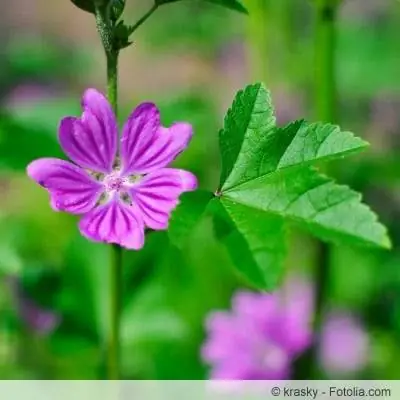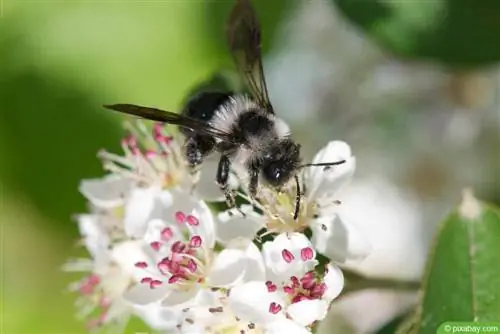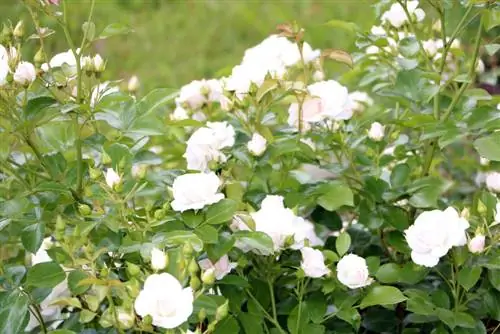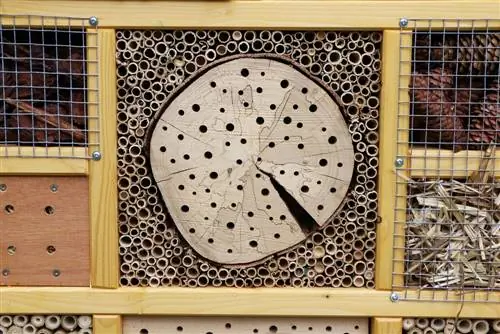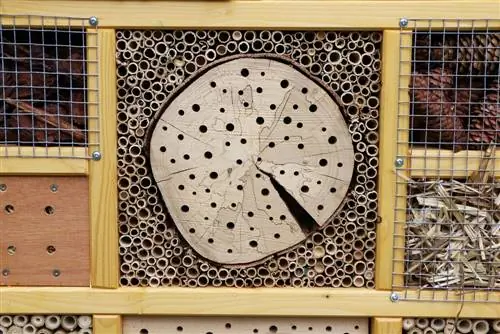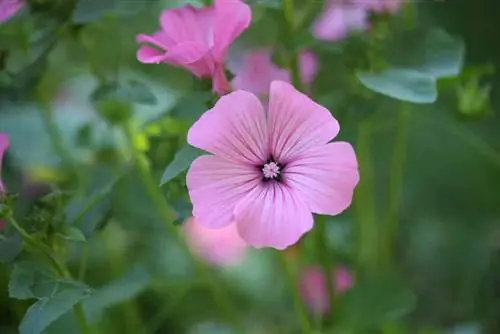- Author admin [email protected].
- Public 2023-12-17 03:39.
- Last modified 2025-01-24 12:45.
With its beautiful cupped flowers, the wild mallow impresses in the cottage garden, along the edges of trees or in the rock garden. Popular and sought-after since ancient times as an ornamental, medicinal, useful and food plant, Malva sylvestris has not lost a bit of its relevance and appeal. The following profile presents the outstanding advantages of this floral all-round talent in a compact and clear manner. In order to enjoy these beneficial attributes, this guide explains all the important details about professional care.
Profile
- Plant family of the mallow family (Malvaceae)
- Plant species within the genus: Wild mallow (Malva sylvestris)
- Rarely annual, mostly biennial or perennial herbaceous plant
- Growth height 50 to 100 cm
- Blue, red or purple flowers with internal stripes
- Flowering from May to September in axillary clusters
- Use of the leaves and flowers as medicinal herbs for stomach, intestinal and cold complaints
- Use of the flowers as an organic yellow dye for food and textiles
- Using the leaves as food in salads and warm dishes
- Other possible uses: vase decoration, fodder plant, green manure, energy plant
- Common names: cheese poplar, horse mallow, piss flower, St. John's poplar
The wild mallow owes its most common common name, cheese poplar, to the fruits whose shape is reminiscent of a wheel of cheese. Our grandmothers and great-grandmothers processed these fruits into a rich children's porridge called cardboard.
Care instructions
In the following you will find detailed instructions for growing and caring for the mallow species.
Location
The wild character of a Malva sylvestris is expressed in a pleasingly flexible attitude towards the site conditions. As long as a wild mallow can capture sunlight for at least 4-6 hours a day, it is content with normal garden soil. The following overview presents all essential requirements:
- Sunny location to light partial shade
- Happy to be warm and protected from the wind
- Nutritious, humus-rich, well-drained soil without the risk of waterlogging
- Fresh to sandy-dry with neutral pH value
While other flowering beauties prefer a rain-protected location, the wild mallow is considered an exception in this regard. In fact, rain is very desirable after the fruit has ripened at the latest, because the cheese wheel-like fruits open, divide and spread only under the pressure of falling water drops.
Pouring
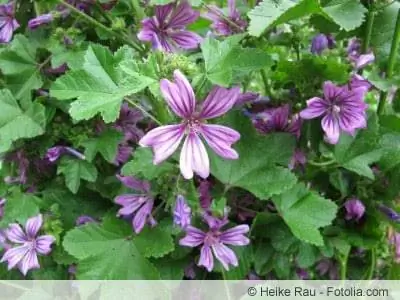
In the first 8-12 weeks after planting, the water requirement of a cheese poplar is at a high level, as rooting occurs in this phase. As the growing season progresses, the summer flower can tolerate short-term drought, but should not dry out completely. Therefore, water a wild mallow regularly when the soil in the top 2 cm has dried out. Avoid overhead watering so that the flowers are not damaged. In the morning or evening, pour the water directly onto the root disc using the can nozzle.
Fertilize
Since a cheeseweed drives a deep taproot into the ground over time, it largely supplies itself with nutrients in the right location. The additional application of fertilizer is therefore not absolutely necessary. So that your floral all-rounder doesn't run out of steam prematurely, a portion of compost replenishes the used energy reserves. Therefore, fertilize a Malva sylvestris every 4 weeks from May to August with an organic fertilizer, such as sifted compost, horn shavings, guano granules, nettle manure or manure.
Cultivated in pots or balcony boxes, the limited substrate volume requires regular fertilizer application. If you pamper your flower artist every two weeks from May to August with an organic liquid fertilizer for flowering plants, you can snack on the flowers and leaves without hesitation.
Tip:
If pond water is used to water a wild mallow, it covers both the water and nutrient requirements. In this case, the additional application of fertilizer is unnecessary.
Cutting
Once a Ross mallow has finished its summer flower festival, cut the plant back to just above the ground. Since the flower does not always thrive perennial, only cut when the fruits have opened and the seeds have dispersed. If the mother plant doesn't come back next year, its seedlings take over the garden.
Wintering
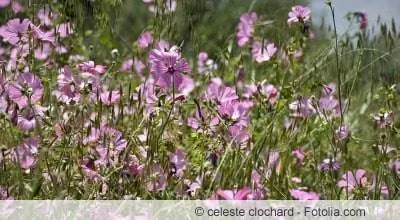
If a wild mallow has retreated into its root ball after the first frost, it can easily tolerate temperatures down to -23 degrees Celsius in the bed. In rough locations, in a bucket and if it is a wild cultivar, we recommend the following precautions for he althy overwintering:
- In the bed after pruning, cover with leaves and conifers
- Cover the bucket with bubble wrap and place it on a block of wood in front of the south wall of the house
- Cover the substrate with autumn leaves, straw or sawdust
It is best to store pots with a diameter of less than 30 cm in frost-free winter quarters. To prevent the root ball from drying out, water it every now and then. As soon as the temperatures permanently exceed the frost limit in early spring, the plant moves to its original place on the balcony or terrace.
Repotting
If spring is at the garden gate, the best time has come to repot Malva sylvestris. This care measure often provides the final impetus to decorate the balcony in the pot or flower box for another season. In any case, the strong root ball has completely rooted through its planter after a year and requires more space. As a substrate, we recommend a structurally stable compost-based pot plant soil, which is made more permeable with a handful of sand, expanded clay or lava granules. How to do it correctly:
- Spread a few pieces of pottery in the new planter over the bottom opening as drainage
- Spread an air- and water-permeable fleece over it so that the material does not become muddy with soil crumbs
- Pour in a first layer of substrate to create a depression in the middle with your fist
- Now unpot the wild mallow and plant it in the fresh substrate so deep that the previous planting depth is retained
After you have watered the cheese poplar, it can recover from the stress of moving for 8 days in a partially shaded location. Only then does it take its place again in the sun under the open sky. Since the pre-fertilized substrate provides sufficient nutrients for the next 4-6 weeks, fertilization is only carried out for the first time after this period.
Tip:
If a strong, vital root ball emerges when repotting, use this opportunity to propagate by division. To do this, cut the wild mallow into 2 or more segments, each of which should have at least 2 eyes. When potted in fresh substrate, the sections transform into adult flowers within a few weeks with exactly the characteristics of their mother plant.
Propagate
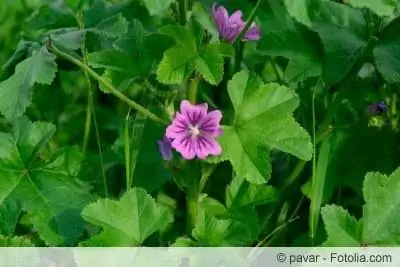
Once you get to know the multi-faceted benefits of wild mallow, you won't want to do without this floral all-rounder. In order to grow more specimens, sowing behind glass is primarily recommended. Alternatively, collect the fruits in autumn to store them in a dry, airtight container until February. Since in this case it is not certain that the seedlings are similar to their mother plant, specialist retailers offer certified seeds that reliably produce the desired variety. This is how sowing works properly:
- Fill small pots or a seed tray with commercially available seed soil or peat sand
- Press the kidney-shaped, brown seeds into the substrate at a distance of 3-4 cm
- Sift thinly with sand or vermiculite and moisten with a fine shower gel
In order to get the somewhat sedate seeds in the mood to germinate, a change between warm and cool temperatures in the following weeks works. First place the seed container in a heated indoor greenhouse at 30 degrees Celsius for 3 weeks. The seeds then spend 3 weeks at 4-5 degrees Celsius, for example in the vegetable compartment of the refrigerator. After the cold stimulus, the seedlings take a partially shaded place on the warm windowsill at 20-21 degrees Celsius. During this time, the seeds must not dry out at any time as they will not recover from drought stress. The seedlings are pricked out when at least 2 pairs of leaves have developed. By mid/end of May, the seeds have developed into vital young plants that can be planted outdoors or in pots.
Tip:
If you invest a little more money in purchasing seeds than golden grain seeds, you can save yourself the effort of changing temperatures during sowing. As gold grain seeds, Malva sylvestris proves to be much more germinative, without any cold irritation.
Beautiful varieties
The wild mallow has given rise to some remarkable varieties that combine the robust wild character with a picturesque abundance of flowers. The following selection provides a brief overview of what is on offer:
- Zebrina: White flowers with a violet eye, 100 cm tall and usually thrives perennial
- Primley Blue: Bright blue flowers from June to September with a height of 40-50 cm
- Demar Marina: Violet flowers, picturesquely striped; reaches a mighty 120-150 cm height
- Twins Hot Pink: Gold medal winner 2005, thanks to pink flowers and high disease resistance
- Purple Satin: Premium variety with purple flowers, a slight shimmer and a growth height of up to 100 cm
In addition, specialist retailers have magnificent mixtures available, such as Mystic Merlin. This impresses with colors in wonderful blue, bright purple and intense violet.
Conclusion
With the wild mallow, Mother Nature has given us a floral jewel that no hobby garden should be without. As this profile shows, Malva sylvestris has a wide range of uses as an ornamental, useful, medicinal and food plant. In order to benefit from the multi-faceted attributes, the gardening maintenance effort is kept within a manageable range. As long as the location is sunny, nutrient-rich and dry to fresh, the magnificent plant thrives and blooms tirelessly. If you wait until the cheese wheel-like fruits have opened and the seeds have dispersed before pruning in autumn, you will be assured of another flower festival next year.

